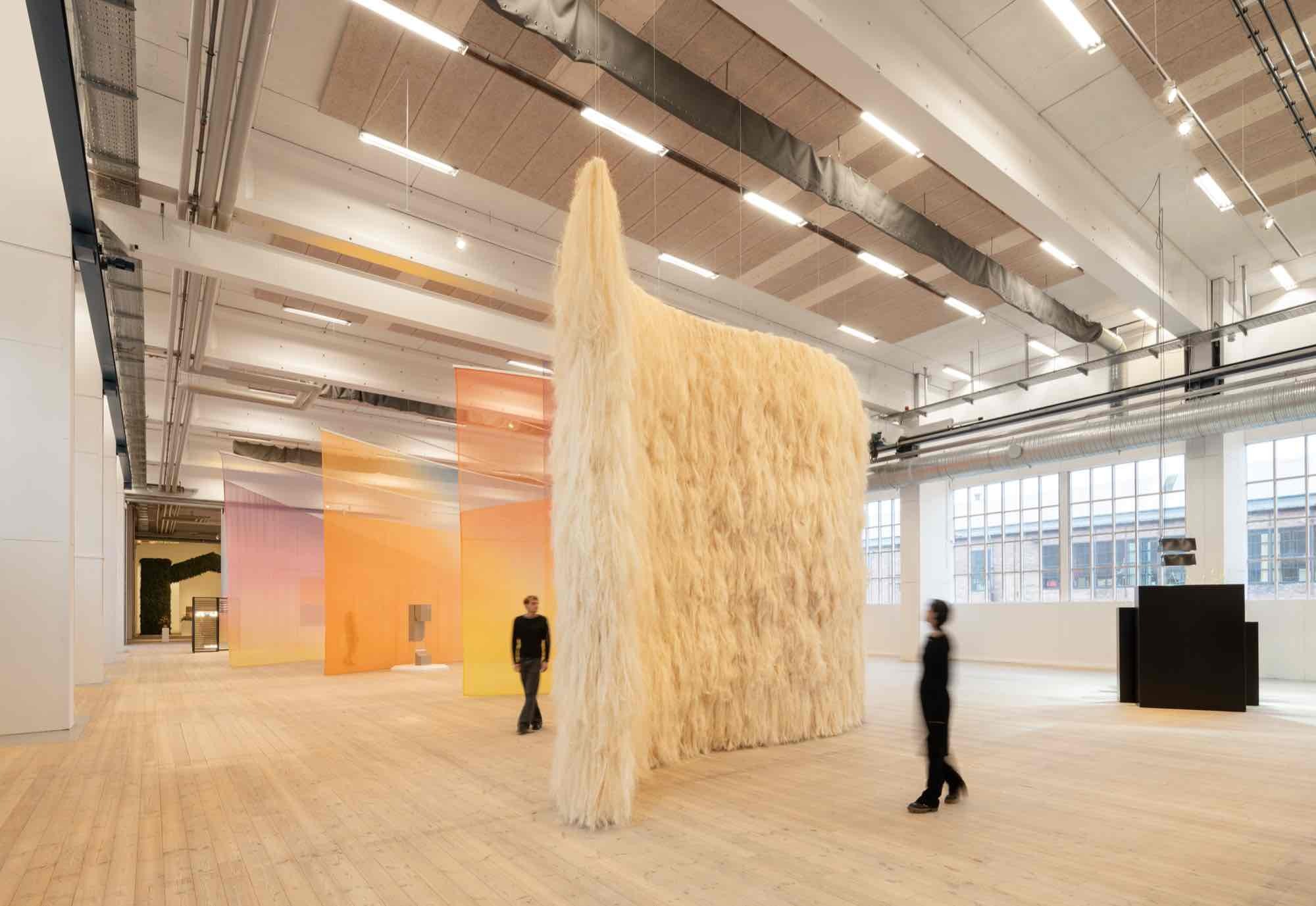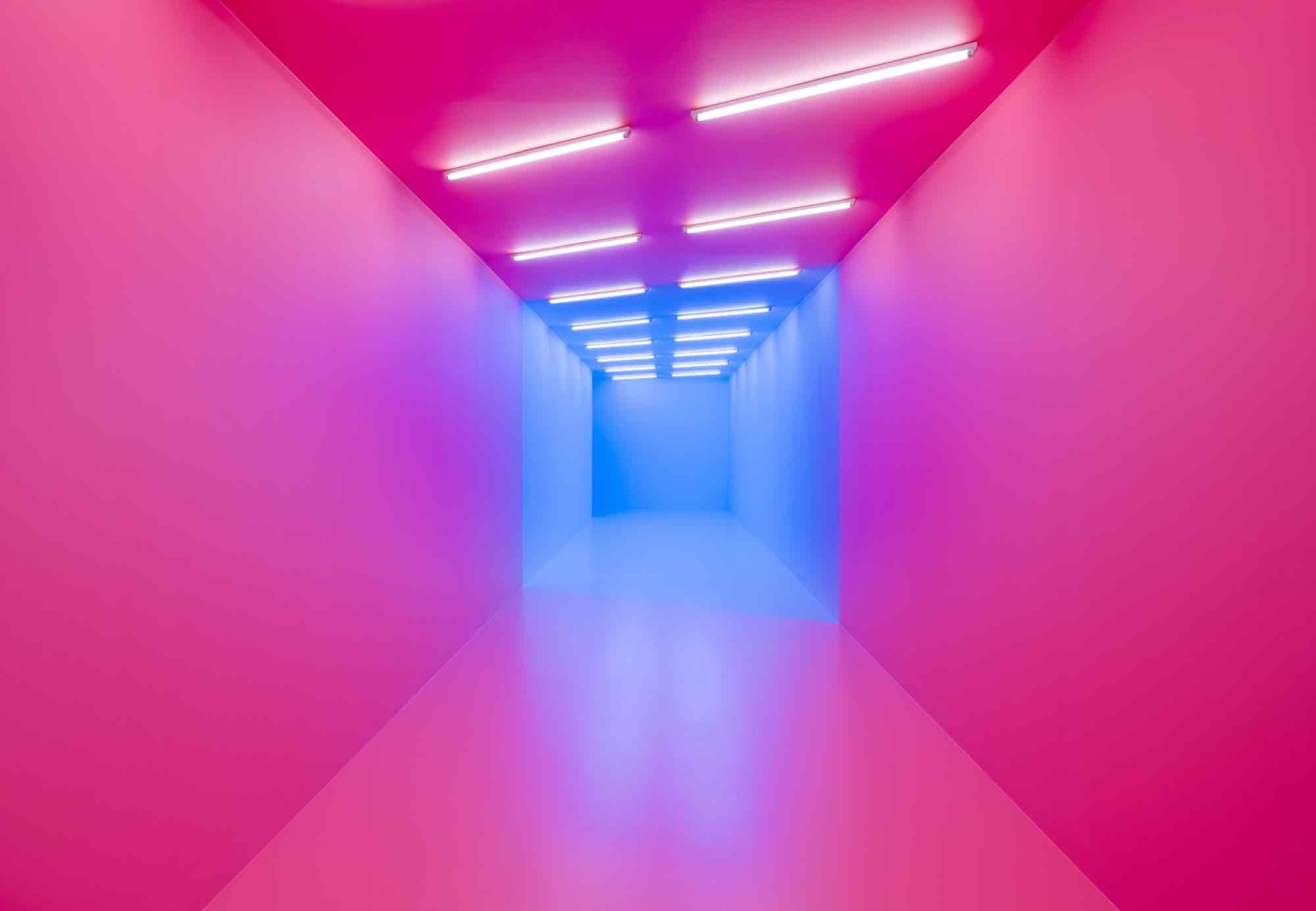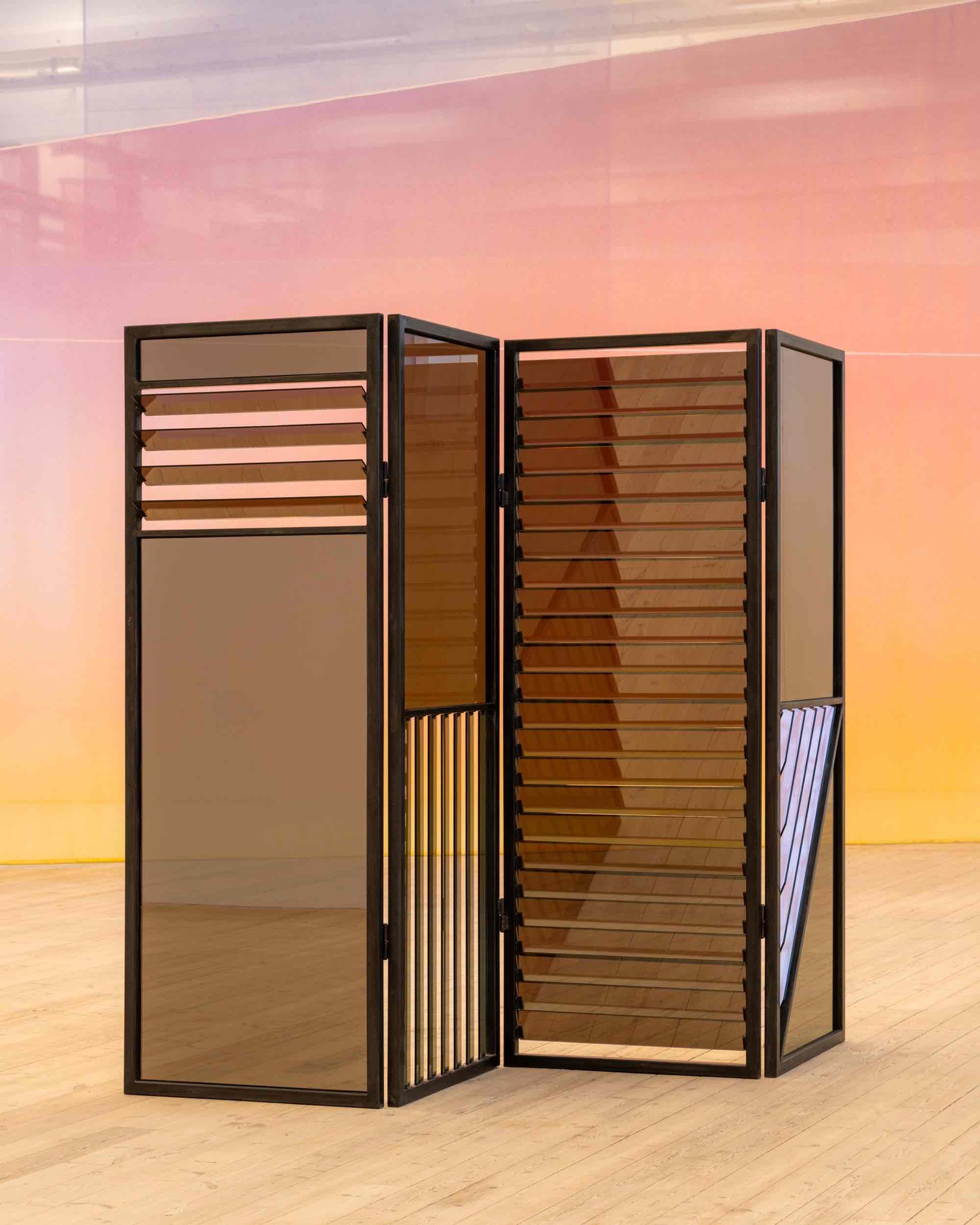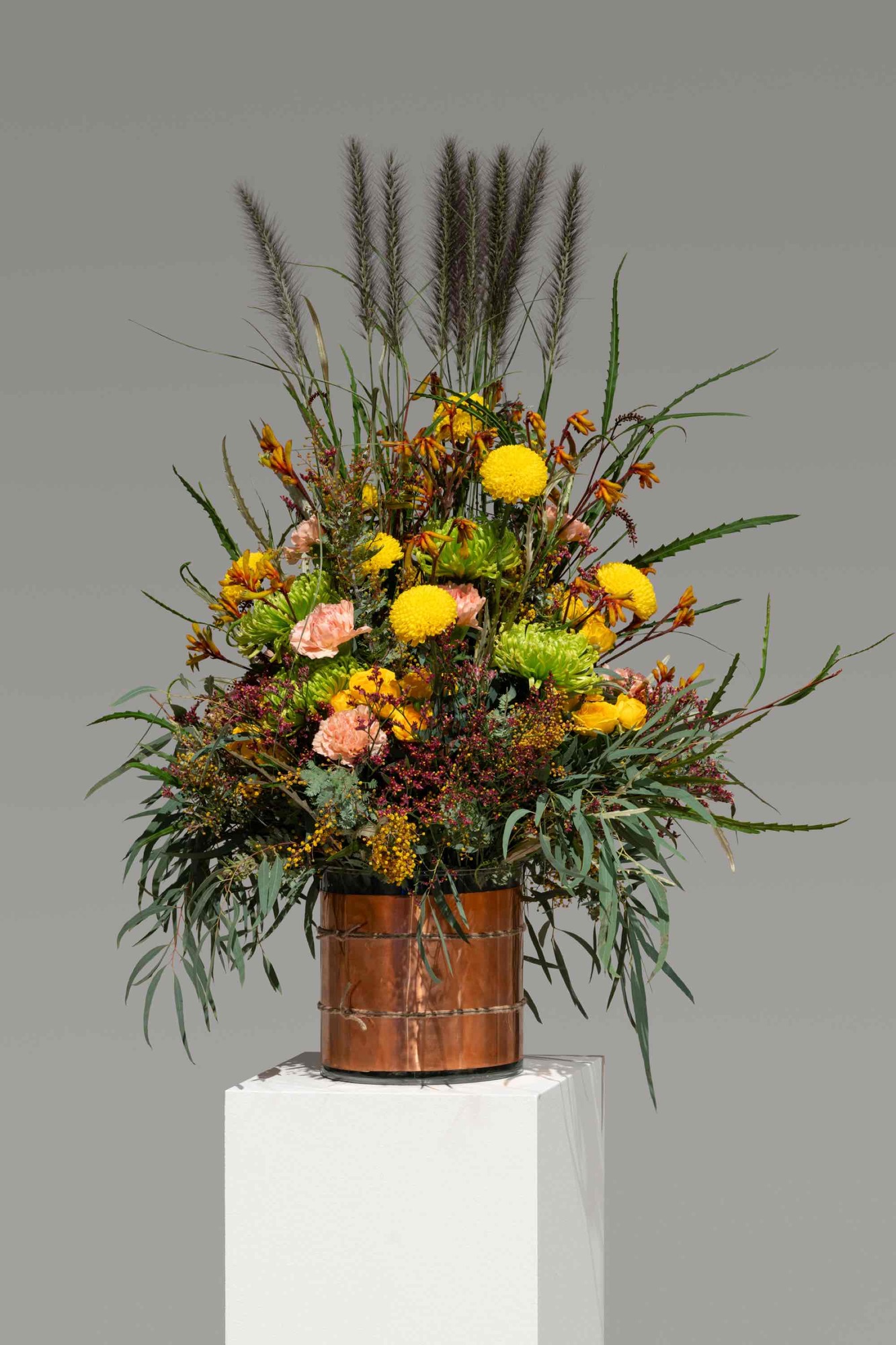Kapwani Kiwanga
The Length of the Horizon
26 Jan - 25 Aug 2024

Kapwani Kiwanga, Terrarium (2022) Installation, Glass, silica sand, fabric, texilte paint, variable dimensions. Installation view, The Length of the Horizon, Copenhagen Contemporary (2024). Photo: David Stjernholm. Courtesy the artist and Goodman Gallery, Cape Town, Johannesburg, London / Galerie Poggi, Paris / Galerie Tanja Wagner, Berlin

Kapwani Kiwanga, Sisal Curve (2024) Sisal fiber, painted steel, 500 × 700 × 146 cm. Production Copenhagen Contemporary & Terrarium (2022) Installation, Glass, silica sand, fabric, texilte paint, variable dimensions. Installation view, The Length of the Horizon, Copenhagen Contemporary (2024). Photo: David Stjernholm. Courtesy the artist and Goodman Gallery, Cape Town, Johannesburg, London / Galerie Poggi, Paris / Galerie Tanja Wagner, Berlin

Kapwani Kiwanga, pink-blue (2017) Baker-Miller pink paint, white paint, white fluorescent lights, blue fluorescent lights, variable dimensions. Installation view,The Length of the Horizon, Copenhagen Contemporary (2024). Photo: David Stjernholm. Courtesy the artist and Goodman Gallery, Cape Town, Johannesburg, London / Galerie Poggi, Paris / Galerie Tanja Wagner, Berlin

Kapwani Kiwanga, The Marias (2020) Paper flowers, customized plinths, paint, variable dimensions. Installation view, The Length of the Horizon, Copenhagen Contemporary (2024). Photo: David Stjernholm. Courtesy the artist and Goodman Gallery, Cape Town, Johannesburg, London / Galerie Poggi, Paris / Galerie Tanja Wagner, Berlin, Collection IAC–Institut d’Art Contemporain, Collection Remai Modern (Purchased with the support of the Frank and Ellen Remai Foundation, 2021) Maja Hoffmann / LUMA Foundation

Kapwani Kiwanga, Terrarium (2022) Installation, Glass, silica sand, fabric, texilte paint, variable dimensions. Installation view, The Length of the Horizon, Copenhagen Contemporary (2024). Photo: David Stjernholm. Courtesy the artist and Goodman Gallery, Cape Town, Johannesburg, London / Galerie Poggi, Paris / Galerie Tanja Wagner, Berlin

Kapwani Kiwanga, Jalousie (2018) Steel, two-way mirror, 220 × 320 × 10 cm Installation view, The Length of the Horizon, Copenhagen Contemporary (2024). Photo: David Stjernholm. Courtesy the artist and Galerie Tanja Wagner, Berlin

Kapwani Kiwanga, Flowers for Africa (2012) Protocol of assembly and display including archival iconography to guide the reconstruction of a floral arrangement consisting of cut flowers, variable dimensions. Installation view,The Length of the Horizon, Copenhagen Contemporary (2024). Photo: David Stjernholm. Courtesy the artist and Goodman Gallery, Cape Town, Johannesburg, London / Galerie Poggi, Paris / Galerie Tanja Wagner, Berlin
For her first major exhibition in Scandinavia, the internationally renowned artist Kapwani Kiwanga (b. 1978) explores social mechanisms and power dynamics through large-scale installations of plants, foliage, sand, colour and light. Just below the surface of Kiwanga’s seductively beautiful works lurk critical themes. Plants tell toxic stories of power imbalances, colours have manipulative effects and light is investigated as a political instrument.
The Length of the Horizon presents a delicate flower on a pedestal bathed in a vibrant yellow environment. The vivid yellow alludes not only to the sunlight required for a plant to grow, but also to stereotypical representations of cheerful tropical sunshine. Showcased are Kiwanga’s two paper versions of the peacock flower (Caesalpinia pulcherrima), with its characteristic green leaves, orange-yellow flowers and long, red stamens. Meticulously rendered at two different stages of growth, they reveal the contrasting historical uses of the flower. Reputed to induce abortion, the decorative plant was a means of resistance and self-determination for people living in the conditions of slavery and indigenous populations in Suriname. Beautifully crafted in paper, Kiwanga’s work alludes also to a pastime in Victorian England, where women of means would craft paper flowers, to decorate their homes. Spotlighting this ornamental plant, Kiwanga lays bare the stark contrast in living conditions between women in imperial England and those living in a colonial territory like Suriname.
Stretching across CC’s two biggest halls and 1600 m2 of space, the exhibition unfolds in a flow created by Kiwanga’s elegant handling of materials and their secrets. With her affinity for captivating, non-static experiences, the artist proposes fluidity as a sculptural principle in works permeated with the idea of continuous re-creation and adaptability.
Kiwanga, who has a degree in anthropology and comparative religion, makes poetic work exploring how objects detached from their original function are given new life in the exhibition space. Handled and displayed, they are distanced from their everyday use and their place in production.
Another work puts up walls of colour forming a 16-metre-long corridor. A recurring motif in Kiwanga’s art is disciplinary architecture – spaces designed to influence human behaviour. One section of the large installation pink-blue is painted in the colour known as Baker-Miller Pink. Purportedly reducing stress and lowering the heart rate, the colour has been used to calm prison inmates. The other section is bathed in blue fluorescent light of the kind installed in public restrooms to make veins harder to see and drugs more difficult to inject. The light is indirectly a tool for surveilling public spaces. In the installation, visitors feel these disorienting effects on their own bodies.
Kapwani Kiwanga knows how to entice aesthetically. The artist’s works offer one the opportunity to go beyond the sensual and visual appreciation to engage with historical sociopolitical dimensions, doubling the effect and giving Kiwanga’s works a lasting impact.
The Length of the Horizon presents a delicate flower on a pedestal bathed in a vibrant yellow environment. The vivid yellow alludes not only to the sunlight required for a plant to grow, but also to stereotypical representations of cheerful tropical sunshine. Showcased are Kiwanga’s two paper versions of the peacock flower (Caesalpinia pulcherrima), with its characteristic green leaves, orange-yellow flowers and long, red stamens. Meticulously rendered at two different stages of growth, they reveal the contrasting historical uses of the flower. Reputed to induce abortion, the decorative plant was a means of resistance and self-determination for people living in the conditions of slavery and indigenous populations in Suriname. Beautifully crafted in paper, Kiwanga’s work alludes also to a pastime in Victorian England, where women of means would craft paper flowers, to decorate their homes. Spotlighting this ornamental plant, Kiwanga lays bare the stark contrast in living conditions between women in imperial England and those living in a colonial territory like Suriname.
Stretching across CC’s two biggest halls and 1600 m2 of space, the exhibition unfolds in a flow created by Kiwanga’s elegant handling of materials and their secrets. With her affinity for captivating, non-static experiences, the artist proposes fluidity as a sculptural principle in works permeated with the idea of continuous re-creation and adaptability.
Kiwanga, who has a degree in anthropology and comparative religion, makes poetic work exploring how objects detached from their original function are given new life in the exhibition space. Handled and displayed, they are distanced from their everyday use and their place in production.
Another work puts up walls of colour forming a 16-metre-long corridor. A recurring motif in Kiwanga’s art is disciplinary architecture – spaces designed to influence human behaviour. One section of the large installation pink-blue is painted in the colour known as Baker-Miller Pink. Purportedly reducing stress and lowering the heart rate, the colour has been used to calm prison inmates. The other section is bathed in blue fluorescent light of the kind installed in public restrooms to make veins harder to see and drugs more difficult to inject. The light is indirectly a tool for surveilling public spaces. In the installation, visitors feel these disorienting effects on their own bodies.
Kapwani Kiwanga knows how to entice aesthetically. The artist’s works offer one the opportunity to go beyond the sensual and visual appreciation to engage with historical sociopolitical dimensions, doubling the effect and giving Kiwanga’s works a lasting impact.
